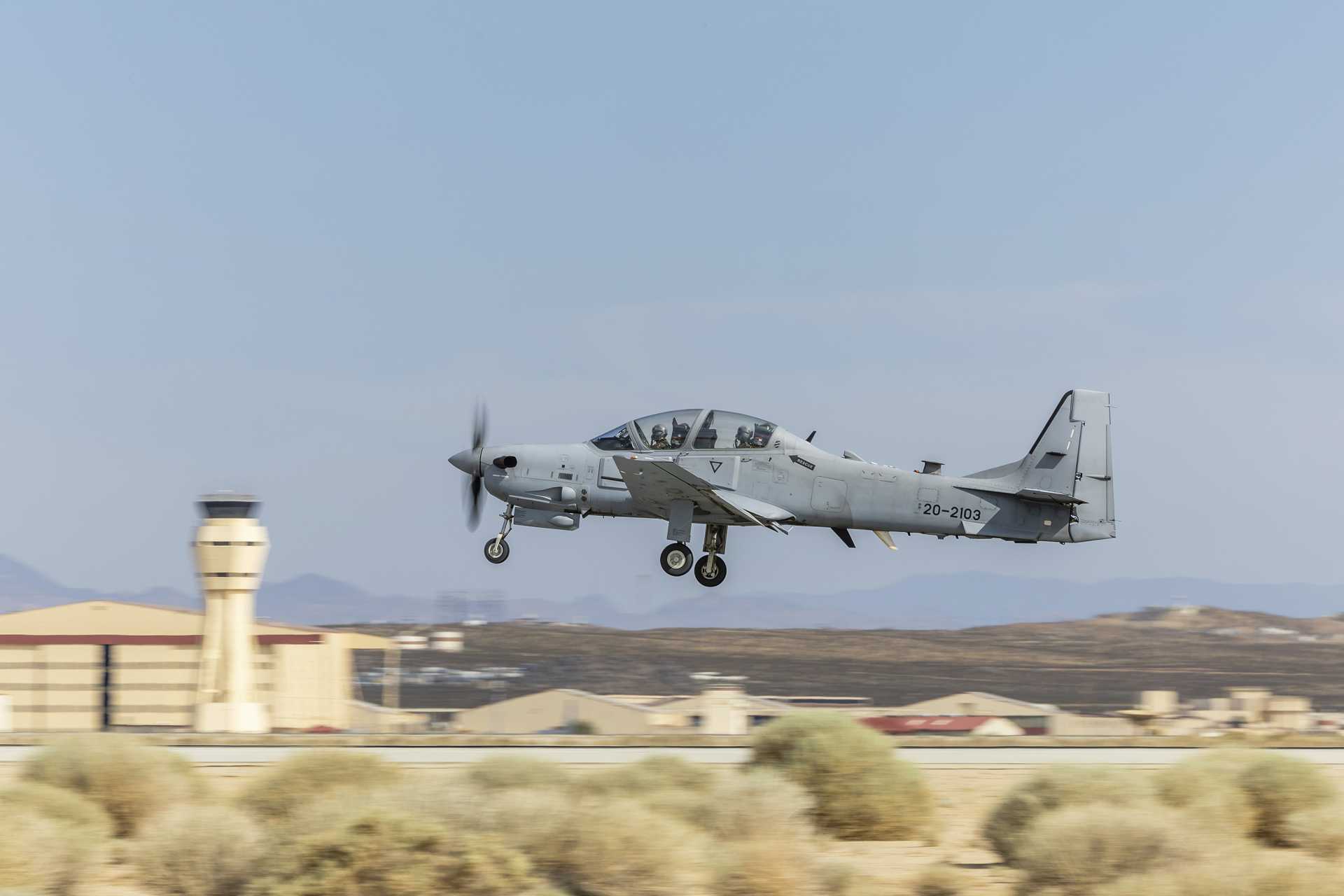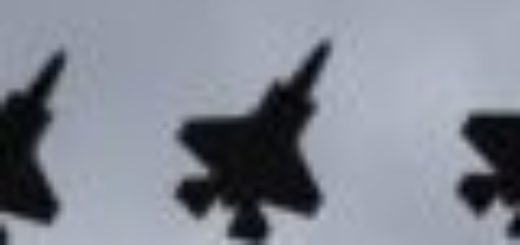U.S. Air Force Integrates A-29C Super Tucano into Pilot Training for Spin and Sensor Instruction

{loadposition bannertop}
{loadposition sidebarpub}
According to information published by the U.S. Department of Defense at the end of June 2025, the U.S. Air Force Test Pilot School (TPS) at Edwards Air Force Base, California, has officially begun integrating the A-29C Super Tucano into its academic and flight training curriculum. The aircraft is now being used by instructors for aerial spin training, mission systems instruction, and research support flights, marking a new phase in the utilization of the light attack and reconnaissance platform within U.S. military education and test operations.Follow Army Recognition on Google News at this link
Instructors at U.S. Air Force Test Pilot School depart Edwards Air Force Base in California during an A-29C Super Tucano training flight. (Picture source: U.S. DoD)
The A-29C’s presence at the U.S. Air Force TPS (Test Pilot School) is the latest development in a broader U.S. Air Force program that began in 2013 with the Light Air Support (LAS) contract. The contract, awarded to Sierra Nevada Corporation (SNC) and Embraer Defense & Security, called for the delivery of A-29 aircraft to support counterinsurgency and close air support (CAS) missions, particularly for partner forces such as the Afghan Air Force. Over the years, the U.S. Air Force acquired a limited number of A-29s for training and evaluation purposes, with further procurements continuing under Foreign Military Sales (FMS) and direct support contracts. In 2021, the U.S. Air Force formally introduced a more advanced variant, the A-29C, built at SNC’s production facility in Jacksonville, Florida, and tailored specifically for U.S. requirements.
The A-29C Super Tucano is a rugged, highly maneuverable turboprop aircraft designed for light attack, armed reconnaissance, forward air control, and intelligence, surveillance, and reconnaissance (ISR) missions. It is equipped with a Pratt & Whitney PT6A-68C engine generating 1,600 shaft horsepower, enabling a top speed of over 320 mph (518 km/h) and a service ceiling above 35,000 feet. The aircraft features a digital glass cockpit with Hands-On Throttle and Stick (HOTAS) controls, Head-Up Display (HUD), advanced mission computers, and open-architecture avionics compatible with NATO standards. It supports a wide variety of precision-guided munitions, rockets, and sensors across five hardpoints, making it highly flexible for both training and combat applications.
In the context of the U.S. Air Force, the A-29C is primarily assigned to training roles, partner nation pilot instruction, and tactical experimentation. It has been deployed in programs such as the Combat Aviation Advisor (CAA) mission under the Air Force Special Operations Command (AFSOC), where U.S. aircrews train and assist allied nations in developing their own air capabilities. The A-29C’s simplicity of operation, combined with its low operational cost and combat-proven reliability, has made it a favored platform for irregular warfare scenarios and austere environments where fast jets are either unsustainable or unnecessary.
The aircraft’s integration into the Test Pilot School adds a new dimension to its utility. At TPS, it will provide a modern and safe turboprop platform for demonstrating and evaluating flight characteristics such as post-stall behavior and controlled spins, along with a valuable environment for testing airborne sensors, mission software, and avionics configurations. The school’s ability to use the A-29C as a research platform also enhances its flight test data acquisition programs, particularly in areas related to sensor fusion, weapons integration, and flight systems evaluation.
By incorporating the A-29C into its fleet, the U.S. Air Force Test Pilot School reinforces its commitment to preparing pilots and engineers for a multi-platform, sensor-integrated battlespace. The aircraft’s arrival symbolizes the growing role of adaptable, cost-effective platforms in future airpower strategies, particularly as the U.S. military shifts focus toward distributed operations, coalition warfare, and agile combat employment in contested environments.
The continued use and integration of the A-29C in both operational and training contexts confirm its value to the U.S. Air Force, not only as a combat-ready light attack platform but also as a vital tool for developing the next generation of aerospace test professionals and tactical advisors.

{loadposition bannertop}
{loadposition sidebarpub}
According to information published by the U.S. Department of Defense at the end of June 2025, the U.S. Air Force Test Pilot School (TPS) at Edwards Air Force Base, California, has officially begun integrating the A-29C Super Tucano into its academic and flight training curriculum. The aircraft is now being used by instructors for aerial spin training, mission systems instruction, and research support flights, marking a new phase in the utilization of the light attack and reconnaissance platform within U.S. military education and test operations.
Follow Army Recognition on Google News at this link
Instructors at U.S. Air Force Test Pilot School depart Edwards Air Force Base in California during an A-29C Super Tucano training flight. (Picture source: U.S. DoD)
The A-29C’s presence at the U.S. Air Force TPS (Test Pilot School) is the latest development in a broader U.S. Air Force program that began in 2013 with the Light Air Support (LAS) contract. The contract, awarded to Sierra Nevada Corporation (SNC) and Embraer Defense & Security, called for the delivery of A-29 aircraft to support counterinsurgency and close air support (CAS) missions, particularly for partner forces such as the Afghan Air Force. Over the years, the U.S. Air Force acquired a limited number of A-29s for training and evaluation purposes, with further procurements continuing under Foreign Military Sales (FMS) and direct support contracts. In 2021, the U.S. Air Force formally introduced a more advanced variant, the A-29C, built at SNC’s production facility in Jacksonville, Florida, and tailored specifically for U.S. requirements.
The A-29C Super Tucano is a rugged, highly maneuverable turboprop aircraft designed for light attack, armed reconnaissance, forward air control, and intelligence, surveillance, and reconnaissance (ISR) missions. It is equipped with a Pratt & Whitney PT6A-68C engine generating 1,600 shaft horsepower, enabling a top speed of over 320 mph (518 km/h) and a service ceiling above 35,000 feet. The aircraft features a digital glass cockpit with Hands-On Throttle and Stick (HOTAS) controls, Head-Up Display (HUD), advanced mission computers, and open-architecture avionics compatible with NATO standards. It supports a wide variety of precision-guided munitions, rockets, and sensors across five hardpoints, making it highly flexible for both training and combat applications.
In the context of the U.S. Air Force, the A-29C is primarily assigned to training roles, partner nation pilot instruction, and tactical experimentation. It has been deployed in programs such as the Combat Aviation Advisor (CAA) mission under the Air Force Special Operations Command (AFSOC), where U.S. aircrews train and assist allied nations in developing their own air capabilities. The A-29C’s simplicity of operation, combined with its low operational cost and combat-proven reliability, has made it a favored platform for irregular warfare scenarios and austere environments where fast jets are either unsustainable or unnecessary.
The aircraft’s integration into the Test Pilot School adds a new dimension to its utility. At TPS, it will provide a modern and safe turboprop platform for demonstrating and evaluating flight characteristics such as post-stall behavior and controlled spins, along with a valuable environment for testing airborne sensors, mission software, and avionics configurations. The school’s ability to use the A-29C as a research platform also enhances its flight test data acquisition programs, particularly in areas related to sensor fusion, weapons integration, and flight systems evaluation.
By incorporating the A-29C into its fleet, the U.S. Air Force Test Pilot School reinforces its commitment to preparing pilots and engineers for a multi-platform, sensor-integrated battlespace. The aircraft’s arrival symbolizes the growing role of adaptable, cost-effective platforms in future airpower strategies, particularly as the U.S. military shifts focus toward distributed operations, coalition warfare, and agile combat employment in contested environments.
The continued use and integration of the A-29C in both operational and training contexts confirm its value to the U.S. Air Force, not only as a combat-ready light attack platform but also as a vital tool for developing the next generation of aerospace test professionals and tactical advisors.





